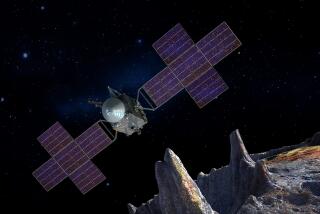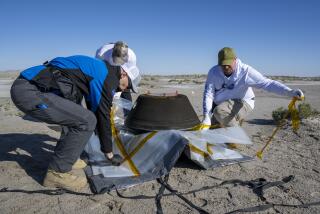Scientists think they have dust specks from outside our solar system
- Share via
Call them the seven wonders of interstellar space: Tiny specks of dust captured by a NASA spacecraft may be the first material from outside the solar system ever caught and brought to Earth.
Researchers studying the contents of a capsule returned to Earth in 2006 at the conclusion of the Stardust spacecraft’s primary mission believe that they have found seven remarkable specks on its collection panels.
Although they weigh about 10 trillionths of a gram in all, the microscopic motes of “alien” dust described in the journal Science could alter astronomers’ perception of the galaxy beyond our own stellar neighborhood.
The Stardust mission was launched in 1999 on a seven-year, 3-billion-mile journey with two separate goals: to collect particles from the tail of the comet Wild-2 and to gather what bits of interstellar dust it could find.
Scientists began examining the collection panels for dust soon after the capsule returned. It was a daunting task.
“It’s not easy to find these things.… What they’ve done in this paper is hugely impressive,” said Scott Messenger, a cosmochemist at NASA’s Johnson Space Center who was not involved in the study.
Once located, the specks could be analyzed to determine their makeup. That research continues, as does study to verify that the dust came from interstellar space and to look for still more dust motes in the panels.
With the seven samples, scientists can examine the individual chemical and structural characteristics of single grains — grains that are proving to be a lot more diverse than many scientists expected.
Some are large and fluffy (about 2 micrometers wide). Others are smaller and denser.
Only two have survived largely intact. Others were smashed out of shape when they crashed into the aluminum foil in the collectors. One was so fast that it probably vaporized, leaving little more than a ghostly trail.
Some of the particles are rich in sulfides, which many scientists did not expect — and such molecules could potentially serve as excellent catalysts for prebiotic chemistry, said study coauthor Rhonda Stroud, a nanoastronomer at the Naval Research Laboratory in Washington.
Two of the fluffy particles sport a crystalline mineral known as olivine — which is surprising because many researchers thought that the extremes of space turned most particles into amorphous, unstructured lumps. That should certainly be the case with any particles blasted out of the heart of an exploding star, which is often how such dust grains are thought to spread through the galaxy and seed other solar systems.
“We’re all made out of recycled dust — and we’re just inherently interested in knowing what the dust we came from was like,” Stroud said. “And this contemporary interstellar dust is giving us an idea of what new solar systems will be made of.”
Each particle has its own unique set of traits — which could mean that they may come from different neighborhoods in the galaxy, or different types of stars, or even the same type of star but in different life stages, Messenger said. Each could have a different cosmic story to tell.
Although each grain is very different from the other, all were incredibly difficult to find.
The grains were caught using collectors shaped like tennis rackets filled with incredibly light silica aerogel and bits of aluminum foil. Many particles that this fragile, airy material was trying to catch were traveling about 20,000 mph. It’s like trying to stop bullets with cotton candy, Stroud said.
But even after Stardust’s successful touchdown, there was another daunting challenge: Finding the tiny tracks in the aerogel that could represent dust grains from outside this solar system. Scientists had to separate them from little shards of spacecraft that had lodged themselves in the delicate material. Scientists also had to examine their paths through the aerogel to make sure they qualified as interstellar dust.
Finding tracks, and telling them apart from other impacters, requires examining an overwhelming number of blown-up microscopic images to look for the right kinds of tracks. It was an impossible amount of work for the team.
“We did the math,” said lead author Andrew Westphal, a physicist at UC Berkeley. “It would take decades of work — and there was just no way we could do it.”
So researchers took what, at the time, was an unusual course — they crowd-sourced the work, recruiting more than 30,000 citizen scientists to comb through the images looking for telltale signs: long, carrot-shaped paths through the aerogel and tiny 3-micrometer craters pocking the aluminum foil. Collectively, they looked through more than 1 million images.
The researchers have gone through a portion of the sample collector. They hope to find a few more once they finish, Westphal said.
Bruce Draine, an astrophysicist at Princeton University who was not involved in the project, said more work needed to be done to confirm that these really are traces of interstellar dust. If so, then there could be many more tracks embedded in the aerogel — they just haven’t been found yet, because most such dust particles are far smaller than these samples.
“To me, this seems like an exciting prospect,” he added.
Understanding dust on such an intimate level is also crucial to understanding measurements of the ancient universe, which are often shrouded by layers of these interstellar grains, Draine said.
That’s not an abstract concept, he added. Such dust — and its effect on the light that reaches our telescopes —- is at the heart of the controversy surrounding recent results from a team of scientists that claimed to have found evidence of the universe’s cosmic inflation after the Big Bang.







